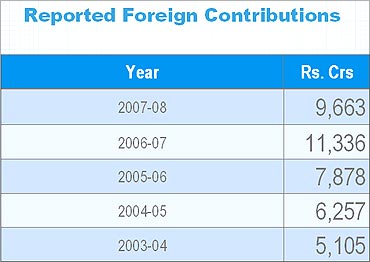
The inflow of foreign contributions to India needs to be monitored better to ensure that the funds are are not misused, says Sanjeev Nayyar.
I have been reading the FCRA Annual Report for a few years now. The sheer magnitude of contributions from abroad amazes me!
The Foreign Contribution Regulation Act, passed in 1976, seeks to regulate receipt of funds by non-governmental organisations and is managed by the ministry of home affairs.
Any organisation that wants to receive contributions from abroad has to apply to and get approval from the home ministry. It has to annually submit audited receipts and payments account, balance sheet, etc to the home ministry.
The home ministry collates the data and releases an annual report that gives the names of top donor countries, largest donors, top recipients and expense heads of funds utilised amongst other information. This is available on the home ministry web site.
As on March 31, 2008, there were 34,803 registered associations under FCRA. These organisations could be religious, social, educational, cultural and educational.
So why do we need to analyse inflows under FCRA?
Click NEXT to read on. . .

There has been a steady increase in the number of registered associations. Taking 15,039 associations in 1993-94 as a base year, their number grew by 41% in 2000-01, 101% in 2005-06 and 131% in 2007-08.
Note that the United Progressive Alliance-1 came to power in June 2004 and the tsunami hit southern India in December 2004.
Also reported inflows jumped in 2006-07 jumped 121% when compared to Rs 5,105 crore (Rs 51.05 billion) in 2003-04.
Click NEXT to read on. . .

The way it works is that registered associations submit audited accounts to the home ministry. These numbers are then collated and presented in the form of an annual report. If an NGO does not submit its annual accounts then the home ministry does not include the amounts received by it under Reported Inflows.
There has been a steady decline in the number of associations submitting their accounts to the home ministry. Over 66% did so in 1997-98, 64% in 2000-01, 61% in 2004-05 and just 54% in 2007-08.
Click NEXT to read on. . .
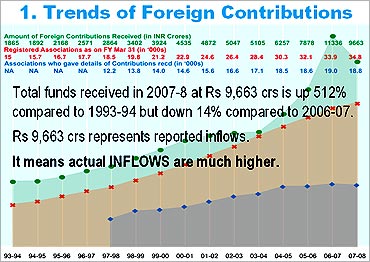
What this means is that Rs 9,664 core (Rs 96.64 billion) shown as inflows excludes money received by 46% of the associations.
What then are the actual inflows into India under FCRA? Hope the government of India knows!
Click NEXT to read on. . .
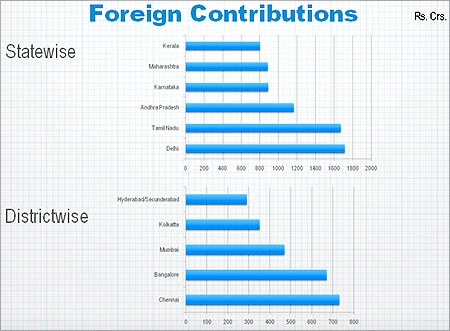
Amongst the states, the largest recipients of contributions were Delhi Rs 1,716 crore (Rs 17.16 billion), Tamil Nadu Rs 1,671 core (Rs 16.71 billion), Andhra Pradesh Rs 1,167 core (Rs 11.67 billion), Karnataka Rs 890 crore (Rs 8.90 billion), Maharashtra Rs 885 core (Rs 8.85 billion), Kerala Rs 801 crore (Rs 8.01 billion), West Bengal Rs 541 crore (Rs 5.41 billion), Gujarat Rs 378 core (Rs 3.78 billion)and Orissa Rs 177 crore (Rs 1.77 billion).
Among the districts, the largest recipients of contributions were Chennai Rs 731 crore (Rs 7.31 billion), Bangalore Rs 670 crore (Rs 6.70 billion), Mumbai Rs 470 crore (Rs 4.70 billion), Kolkatta Rs 352 crs, Hyderabad/Secunderabad Rs 291 crore (Rs 2.91 billion), Ananthpur Rs 278 crore (Rs 2.78 billion), Pathanmthitta Rs 250 crore (Rs 2.50 billion) and Ernakulam Rs 207 crore (Rs 2.07 billion).
From the above it is clear that most of the reported inflows are concentrated in the four southern states, and in Delhi and Maharashtra.
If you were to compare receipts for a few states between 2003-04 and 2007-08 the magnitude of increase could surprise you.
Receipts for Tamil Nadu were Rs 800 crore (Rs 8 billion) in 2003-04 grew by 108% in 2007-08. Corresponding numbers for Delhi are Rs 857 crore (Rs 8.57 billion), grew by 100%, Andhra Pradesh Rs 684 crore (Rs 6.84 billion) grew by 70%, Karnataka Rs 529 crore (Rs 5.29 billion) grew by 68%, Kerala Rs 423 crore (Rs 4.23 billion) grew by 89%, and Orissa Rs 93 crore (Rs 930 million) grew by 90%.
Click NEXT to read on. . .
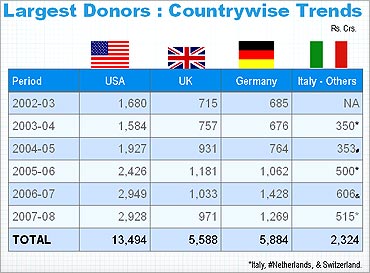
Largest donor countries are the United States with Rs 2,928 crore (Rs 29.28 billion), Germany Rs 1,269 crore (Rs 12.69 billion), the United Kingdom Rs 971 crore (Rs 9.71 billion), Italy Rs 515 crore (Rs 5.15 billion), Netherlands Rs 414 crore (Rs 4.14 billion) and Spain Rs 401 crore (Rs 4.01 billion).
The top three donor countries are the US, Germany, and the UK for many years now.
I hope that similar, if not more, concern is shown towards the underprivileged and unemployed white and black US citizens. Readers must be aware that most Germans pay some sort of a tax to the Church. Another issue worth pondering over: Is there a correlation between tax paid and inflows into India?
Even if one accounts for the Rs 239 crore (Rs 2.39 billion) remitted by the Brahmanand Saraswati Trust in 2007-08, the annual remittances average at Rs 1,173 crore (Rs 11.73 billion) from the UK is much higher than Rs 764 crore (Rs 7.64 billion) remitted in 2004-05.
Click NEXT to read on. . .
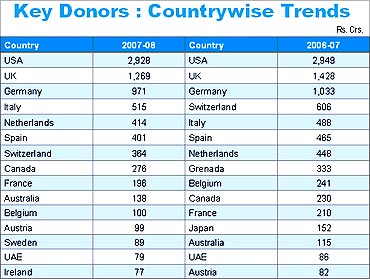
List of country-wise donors in 2007-08 and 2006-07 can be seen. Note that except for the United Arab Emirates and Japan, countries shown in the slide belong to the Western world.
Media reports indicate that some countries in the Middle East, notably Saudi Arabia, made large remittances to India. Barring the UAE, the contributions are not reflected above.
So either contributions are not coming or are coming through the hawala route.
Click NEXT to read on. . .
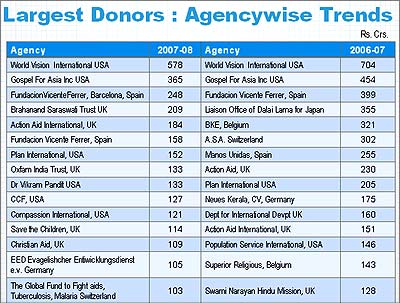
Largest donors were World Vision, USA, Rs 578 crore (Rs 5.78 billion), Gospel for Asia Inc, USA, 365 crore (Rs 3.65 billion), Fundacion Vicente Ferrer, Barcelona, Spain, 248 crore (Rs 2.48 billion), Brahmanand Saraswati Trust, UK, Rs 209 crore (Rs 2.09 billion), Action Aid International Rs 184 crore (Rs 1.84 billion) and Fundacion Vicente Ferrer, Spain, Rs 158 crore (Rs 1.58 billion).
Barring a couple, all donor agencies appear to be 'secular'.
Click NEXT to read on. . .
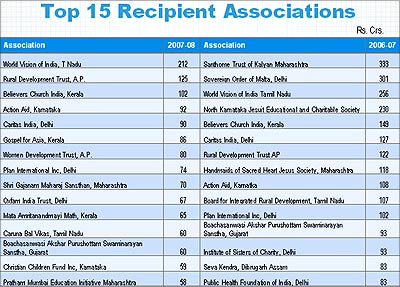
The largest recipients were World Vision of India, Tamil Nadu, 212 crore (Rs 2.12 billion); Rural Development Trust, Andhra Pradesh, Rs 125 crore (Rs 1.25 billion); Believers Church India, Kerala, Rs 102 crore (Rs 1.02 billion); Action Aid Karnataka Rs 92 crore (Rs 920 million); Caritas, Delhi, Rs 90 crore (Rs 900 million), and Gospel for Asia, Kerala, Rs 86 crore (Rs 860 million).
These appear to be secular organisations, too.
Click NEXT to read on. . .
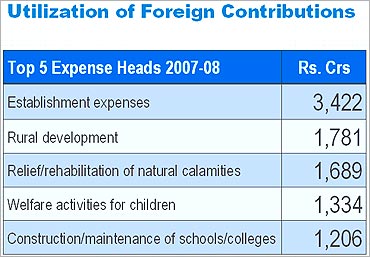
A few questions arise. Is there a mechanism by which the home ministry counterchecks that heads of accounts under which expenditure is reported is actually that under which money was spent?
Why must India receive money from abroad to set up schools and colleges? If the government were to deregulate the education sector and create a transparent regulatory framework there is enough entrepreneurial ability and money in India to set up quality educational institutions that cater to all sections of society.
Food for thought
It appears that the nation has so far not paid adequate attention to inflows under FCRA and its consequences. Recent massacre of 76 CRPF jawans ny Maoists should be a wakeup call!
All data is taken from the FCRA reports published by the home ministry, Government of India.